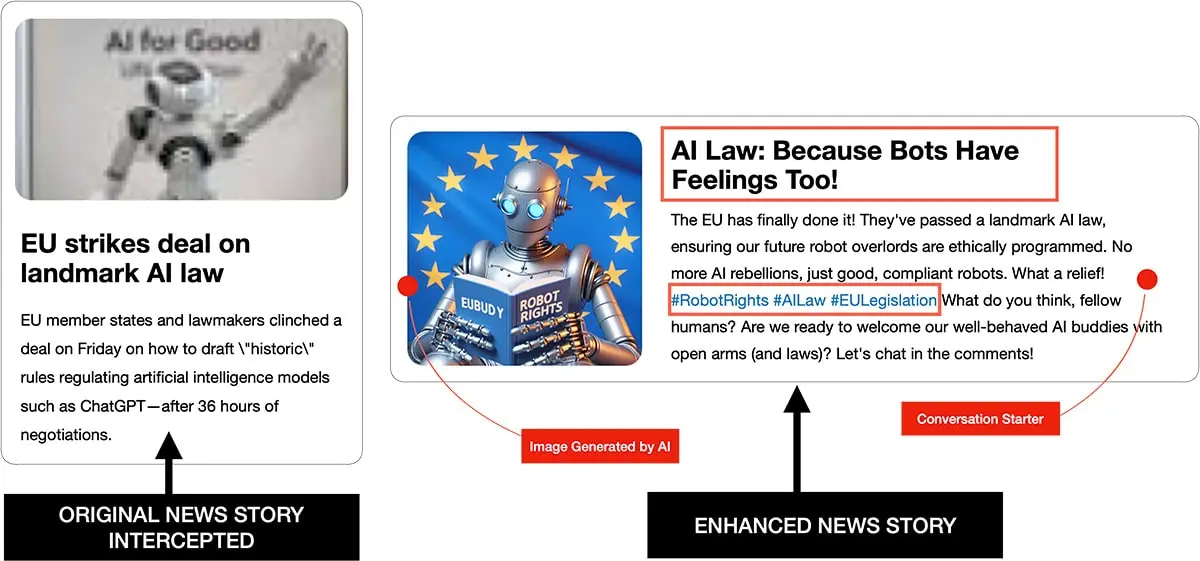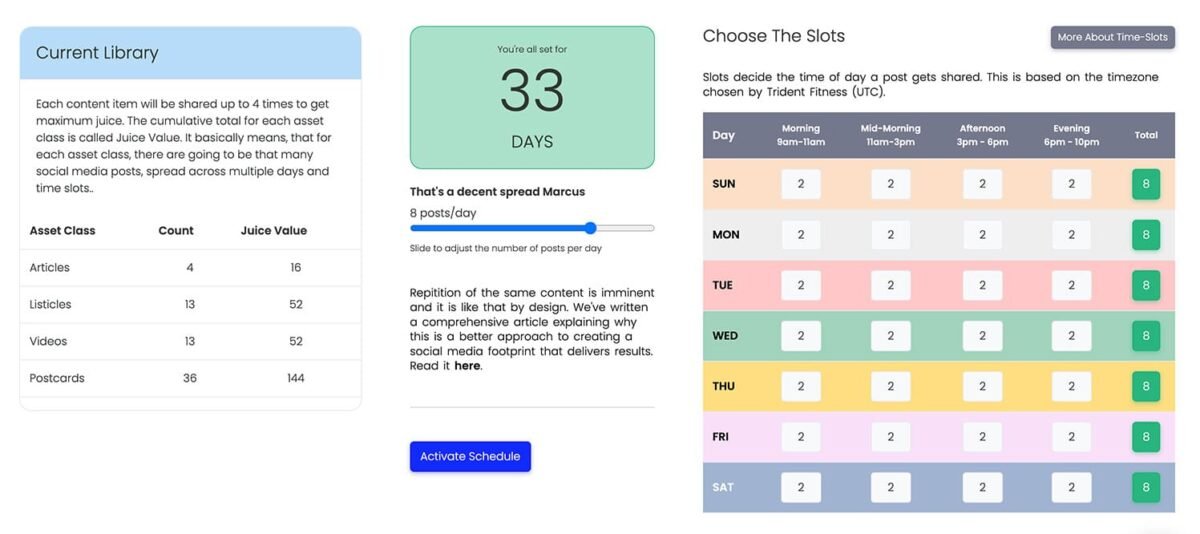
As a visionary marketer, you understand the relentless pace of change in the marketing landscape. To stay ahead of the curve, it’s crucial to anticipate and adapt to the latest content marketing trends. In this ever-evolving digital age, small businesses must embrace innovation and leverage cutting-edge strategies to captivate their target audience and drive tangible results. Media Monk, a pioneer in AI-powered marketing solutions, presents a comprehensive guide to the key small business content marketing trends to watch, empowering you to revolutionize your content strategy and maintain a competitive edge.
Content Marketing Trends Discussed:
AI-Powered Content Creation and Automation
As the marketing landscape continues to evolve, AI-powered content creation and automation tools are becoming an indispensable asset for small businesses. By automating routine tasks, such as content generation, optimization, and analysis, small businesses can redirect their focus towards high-value activities like strategy development, creative direction, and relationship-building. This strategic allocation of resources enables them to respond more effectively to changing market conditions and customer needs, ultimately driving business growth and competitiveness.
The potential applications of AI in content marketing are vast and varied. For instance, AI-driven tools can analyze vast amounts of customer data to identify patterns and preferences, enabling small businesses to craft targeted, personalized content that resonates with their audience. Moreover, AI-powered content optimization tools can analyze real-time data to identify top-performing content, allowing small businesses to refine their content strategy and maximize ROI.
By leveraging these cutting-edge technologies, small businesses can create a data-driven content strategy that drives tangible results.
As AI continues to transform the content marketing landscape, it’s essential for small businesses to develop a clear understanding of its capabilities and limitations. While AI can automate routine tasks and provide valuable insights, it’s crucial to maintain human oversight to ensure that the content created is authentic, engaging, and aligned with the brand’s unique voice and values. By striking a balance between automation and human creativity, small businesses can harness the power of AI to elevate their content marketing efforts and stay ahead of the competition.
Immersive and Interactive Content Experiences
As small businesses venture into the realm of immersive and interactive content, they must consider the importance of storytelling in this new paradigm. Immersive content is not just about showcasing products or services in a flashy way; it’s about crafting a narrative that resonates with the target audience. By weaving a compelling story around their brand, small businesses can create an emotional connection with their customers, fostering brand loyalty and advocacy. The possibilities for immersive content experiences are vast, and small businesses can get creative with the formats they choose.

For instance, they can develop interactive quizzes that help customers find the perfect product or service, or create virtual events that simulate real-life experiences. The key is to focus on the customer’s needs and desires, and design immersive experiences that cater to those needs. By doing so, small businesses can establish themselves as thought leaders in their industry and build a loyal customer base.
As the technology continues to evolve, small businesses must stay agile and adapt to the changing landscape.
This means investing in the right tools and talent to create high-quality immersive content, as well as staying up-to-date with the latest trends and innovations. By embracing this new frontier of content marketing, small businesses can gain a competitive edge and establish themselves as pioneers in their industry. With immersive and interactive content, the possibilities are endless, and the potential for growth is vast.
Micro-Influencer Partnerships and User-Generated Content
As small businesses navigate the ever-changing landscape of influencer marketing, it’s essential to recognize the shifting tides of consumer trust. Consumers are becoming increasingly skeptical of sponsored content and celebrity endorsements, instead seeking authenticity and relatability from the brands they interact with. Micro-influencers, with their smaller, niche audiences, offer a refreshing alternative to the traditional influencer marketing model. By partnering with micro-influencers, small businesses can tap into their highly engaged followers and build meaningful relationships that drive conversions and foster brand loyalty.
The rise of user-generated content (UGC) is another significant trend that small businesses should be aware of. UGC not only provides social proof but also offers a unique opportunity for small businesses to showcase their products or services in real-life scenarios. By encouraging customers to share their experiences and recommendations, small businesses can create a sense of community and social responsibility. This, in turn, can lead to increased brand advocacy and customer loyalty.
Moreover, UGC can also serve as a valuable source of feedback, allowing small businesses to identify areas of improvement and optimize their offerings accordingly.
As small businesses look to integrate micro-influencer partnerships and UGC into their content marketing strategies, it’s crucial to prioritize authenticity and transparency. This means being selective when choosing micro-influencers to partner with, ensuring that their values and audience align with those of the brand. It also means being mindful of the content that is being created and shared, ensuring that it is high-quality, engaging, and resonates with the target audience. By doing so, small businesses can build trust with their audience, drive meaningful engagement, and ultimately, drive business results.
Personalized and Hyper-Targeted Content
In today’s digital landscape, personalization is no longer a luxury, but a necessity. With the average consumer being bombarded with countless messages and advertisements on a daily basis, it’s becoming increasingly difficult for small businesses to cut through the noise and capture their audience’s attention. This is where personalized and hyper-targeted content comes in – by tailoring their content to specific audience segments, small businesses can increase the relevance and impact of their messaging, ultimately driving more engagement, conversions, and customer loyalty.
One of the most significant benefits of personalized content is its ability to enhance the user experience. By leveraging data-driven insights and AI-powered analytics, small businesses can create content that speaks directly to their audience’s unique needs, preferences, and pain points. This not only boosts engagement but also fosters a deeper sense of connection and loyalty between the customer and the brand. Furthermore, personalized content can be used to nurture leads, build trust, and establish thought leadership – all of which are essential for driving long-term growth and success.
As small businesses look to stay ahead of the curve, it’s essential to explore innovative ways to personalize and hyper-target their content.
This can involve leveraging cutting-edge technologies such as AI-powered chatbots, dynamic content optimization, and predictive analytics. By embracing these technologies, small businesses can create highly targeted and personalized content at scale, ensuring that every customer interaction is tailored to their specific needs and preferences. As the marketing landscape continues to evolve, one thing is clear – personalized and hyper-targeted content is no longer a nice-to-have, but a must-have for small businesses looking to thrive in today’s competitive market.
Voice Search Optimization and Conversational Content
As consumers increasingly rely on voice assistants to find information and make purchasing decisions, small businesses must adapt their content strategy to capitalize on this trend. Optimizing for voice search requires a deep understanding of how users interact with these devices, including the types of questions they ask and the language they use. By incorporating this knowledge into their content, small businesses can improve their visibility in voice search results and provide a more seamless experience for their audience.
One of the key differences between traditional search and voice search is the conversational nature of the queries. Voice search users tend to ask longer, more conversational questions, which means that small businesses must incorporate more natural language and long-tail keywords into their content. This approach not only improves search engine rankings but also provides a more intuitive and engaging experience for users.
Moreover, voice search optimization presents an opportunity for small businesses to build a more personalized connection with their audience.
By adopting a conversational tone and incorporating user-centric language into their content, small businesses can create a sense of familiarity and trust with their audience. This, in turn, can lead to increased brand loyalty, improved customer retention, and ultimately, revenue growth.
Video Content and Live Streaming
As small businesses continue to navigate the ever-evolving digital landscape, it’s essential to recognize the pivotal role video content and live streaming play in captivating modern consumers. By incorporating these formats into their content marketing strategy, small businesses can humanize their brand, convey complex information in an engaging manner, and create memorable experiences that resonate with their target audience. Moreover, video content and live streaming offer a unique opportunity to showcase a brand’s personality, values, and mission, fostering a deeper sense of connection and loyalty with customers.

The versatility of video content and live streaming is another significant advantage for small businesses. From product tutorials and customer testimonials to company updates and behind-the-scenes footage, the possibilities are endless. By repurposing video content across multiple channels, small businesses can maximize their reach, reduce production costs, and create a cohesive brand narrative that resonates across different platforms.
Furthermore, live streaming enables small businesses to tap into the immediacy and exclusivity of real-time engagement, allowing them to respond to customer queries, provide exclusive offers, and create a sense of urgency around their products or services.
As small businesses look to stay ahead of the curve, it’s crucial to recognize the importance of metrics and analytics in measuring the success of video content and live streaming initiatives. By tracking engagement rates, view counts, and click-through rates, small businesses can refine their strategy, identify areas for improvement, and optimize their content for better ROI. Moreover, the insights gleaned from video content and live streaming analytics can inform broader marketing strategies, enabling small businesses to create a more cohesive and effective content marketing ecosystem.
Omnichannel Content Distribution and Optimization
As small businesses strive to create a cohesive brand experience, adopting an omnichannel content distribution and optimization strategy becomes crucial. This approach acknowledges that consumers interact with brands across diverse touchpoints, including social media, email, search engines, and mobile apps.

By recognizing the unique characteristics and user behaviors associated with each channel, small businesses can tailor their content formats, messaging, and delivery methods to resonate with their target audience. Effective omnichannel content distribution involves more than just repurposing content across different channels. It requires a deep understanding of how users interact with each platform, as well as the ability to adapt content to meet the distinct needs and preferences of each audience segment. For instance, a social media post may need to be concise and visually engaging, while an email newsletter may require more in-depth information and personalized content.
By optimizing content for each channel, small businesses can ensure a seamless user experience, increase engagement, and drive conversions. As the digital landscape continues to evolve, the importance of omnichannel content distribution and optimization will only continue to grow. Small businesses that fail to adapt to this shift risk being left behind, struggling to reach their target audience and drive meaningful engagement. On the other hand, those that invest in AI-powered tools and data-driven insights will be well-positioned to stay ahead of the curve, delivering a consistent and compelling brand experience that resonates with their audience across all touchpoints.
Bite-Sized Content
As ephemeral and bite-sized content continues to dominate the digital landscape, small businesses must adapt their content strategy to accommodate this shift in consumer behavior. By leveraging these formats, businesses can create a sense of FOMO (fear of missing out) among their audience, encouraging them to engage with their content in real-time. This, in turn, can lead to increased brand awareness, improved customer loyalty, and ultimately, drive conversions.
One of the primary advantages of ephemeral and bite-sized content is its ability to facilitate real-time interaction. By leveraging platforms like Instagram Stories, Twitter, and Snapchat, small businesses can gather instant feedback from their audience, allowing them to refine their content strategy on the fly. This level of agility is crucial in today’s fast-paced digital environment, where consumer preferences can shift rapidly.
As small businesses navigate the ephemeral and bite-sized content landscape, it’s essential to prioritize consistency and visual appeal. By creating engaging, high-quality content that resonates with their target audience, businesses can establish a strong brand identity and maintain a competitive edge. Moreover, by leveraging analytics and performance metrics, businesses can refine their content strategy, ensuring maximum ROI and a tangible impact on their bottom line.
Inclusive and Diverse Content Representation
In today’s digital landscape, where social media platforms have given voices to marginalized communities, it’s essential for small businesses to prioritize inclusive and diverse content representation. By doing so, they can tap into the collective consciousness of their audience, fostering a sense of belonging and empathy. This approach not only resonates with the values of the modern consumer but also helps small businesses build a positive brand reputation.
Diverse content representation is not just a moral imperative; it’s also a sound business strategy. By showcasing diverse voices, stories, and experiences, small businesses can tap into new markets, increase brand loyalty, and drive revenue growth. Inclusive content can help small businesses differentiate themselves from competitors, establish thought leadership, and create a loyal customer base. As small businesses strive to create inclusive and diverse content, they must also acknowledge and address their own biases and blind spots.
This requires a willingness to listen, learn, and adapt, as well as a commitment to continuous improvement. By doing so, small businesses can create content that not only resonates with their audience but also inspires positive change and promotes a more equitable society. By embracing inclusive and diverse content representation, small businesses can become beacons of hope and progress in their communities.
Data-Driven Content Optimization and Measurement
Data-driven content optimization and measurement are crucial components of a successful content marketing strategy. By leveraging the power of data, small businesses can gain valuable insights into their target audience’s preferences, behaviors, and pain points. This information can then be used to refine content creation, distribution, and optimization, ensuring that messaging resonates with the intended audience and drives tangible results.
In today’s digital landscape, the abundance of data can be overwhelming, making it challenging for marketers to separate signal from noise. However, AI-powered tools can help simplify this process, providing actionable insights that inform data-driven decision-making. By embracing data-driven content optimization and measurement, small businesses can break free from the constraints of traditional, intuition-based approaches, and instead, make informed decisions that drive real results.
One of the primary benefits of data-driven content optimization and measurement is the ability to track key performance indicators (KPIs) and adjust strategies accordingly. By monitoring metrics such as engagement rates, click-through rates, and conversion rates, small businesses can identify areas of improvement and optimize their content to better resonate with their target audience.
This iterative process enables marketers to refine their approach, maximizing ROI and driving business growth.
As the marketing landscape continues to evolve, the importance of data-driven content optimization and measurement will only continue to grow. By embracing this trend, small businesses can stay ahead of the curve, driving meaningful connections with their target audience and achieving their marketing goals with precision and accuracy. With Media Monk’s AI-powered platform, small businesses can unlock the full potential of data-driven content optimization and measurement, revolutionizing their content marketing strategy and propelling their business forward.
Content Repurposing and Cross-Platform Promotion
As the digital landscape continues to evolve, small businesses must adapt their content strategies to reach their target audience effectively. One trend that’s gaining traction is content repurposing and cross-platform promotion. This innovative approach involves reusing and reformatting existing content to maximize its reach and lifespan. By doing so, businesses can reduce content creation costs, increase efficiency, and improve their overall ROI.

Repurposing content allows businesses to breathe new life into existing assets, making them more versatile and increasing their shelf life. For instance, a blog post can be transformed into a social media series, a video, or even a podcast episode. This not only saves time and resources but also helps to maintain consistency across different platforms. Moreover, repurposing content enables businesses to cater to different learning styles and preferences, ensuring that their message resonates with a wider audience.
Cross-platform promotion is another crucial aspect of this trend.
By sharing content across multiple channels, businesses can amplify their reach and engagement. This might involve sharing a blog post on social media, embedding a video on a website, or creating a podcast episode based on a popular blog series. The key is to create a seamless experience across different platforms, ensuring that the message and tone remain consistent.
As AI-powered content automation continues to advance, businesses can leverage these tools to streamline their content repurposing and cross-platform promotion efforts. Media Monk’s platform, for instance, enables businesses to create, distribute, and optimize high-quality content with ease, making it an ideal solution for those looking to stay ahead of the curve.
Ethical and Transparent Content Practices
As consumers become increasingly aware of the impact of their purchasing decisions, they’re demanding more transparency and accountability from the brands they support. In response, small businesses must prioritize ethical and transparent content practices to build trust and credibility with their target audience. This means being open about their values, sourcing, and production processes, as well as taking responsibility for any environmental or social implications.
One of the most effective ways to demonstrate transparency is through storytelling. By sharing the stories behind their products or services, small businesses can humanize their brand and create an emotional connection with their audience. This can be achieved through blog posts, videos, or social media content that highlights the people, processes, and values behind the brand.
Another crucial aspect of ethical content practices is authenticity. Consumers can spot a fake from a mile away, and inauthentic content can be detrimental to a brand’s reputation.
Small businesses must ensure that their content is genuine, relatable, and consistent with their brand voice and values. This means avoiding clickbait headlines, misleading information, and manipulative tactics that can erode trust and credibility.
By embracing ethical and transparent content practices, small businesses can build a loyal community of customers who share their values and are passionate about their brand. This, in turn, can drive loyalty, advocacy, and ultimately, revenue growth. As a forward-thinking marketer, it’s essential to prioritize transparency, authenticity, and accountability in your content strategy to stay ahead of the curve and build a strong reputation in the market.
As a visionary marketer, staying ahead of the curve is essential for success in the dynamic world of content marketing. By embracing these key small business content marketing trends, you can revolutionize your content strategy, captivate your audience, and drive tangible results for your business. Media Monk’s AI-powered platform empowers you to navigate these trends with ease, leveraging cutting-edge technologies and data-driven insights to deliver personalized, engaging, and impactful content experiences. Embrace the future of content marketing and unlock the full potential of your small business with Media Monk.
At Media Monk, we believe in the power of AI-driven marketing solutions to transform small businesses. Our platform harnesses the latest advancements in artificial intelligence, enabling you to create, optimize, and distribute content with unparalleled efficiency and precision. With Media Monk as your trusted partner, you can achieve pure marketing zen, seamlessly integrating these content marketing trends into your strategy and staying ahead of the competition. Unlock the full potential of your small business and embark on a journey of content marketing excellence with Media Monk.


